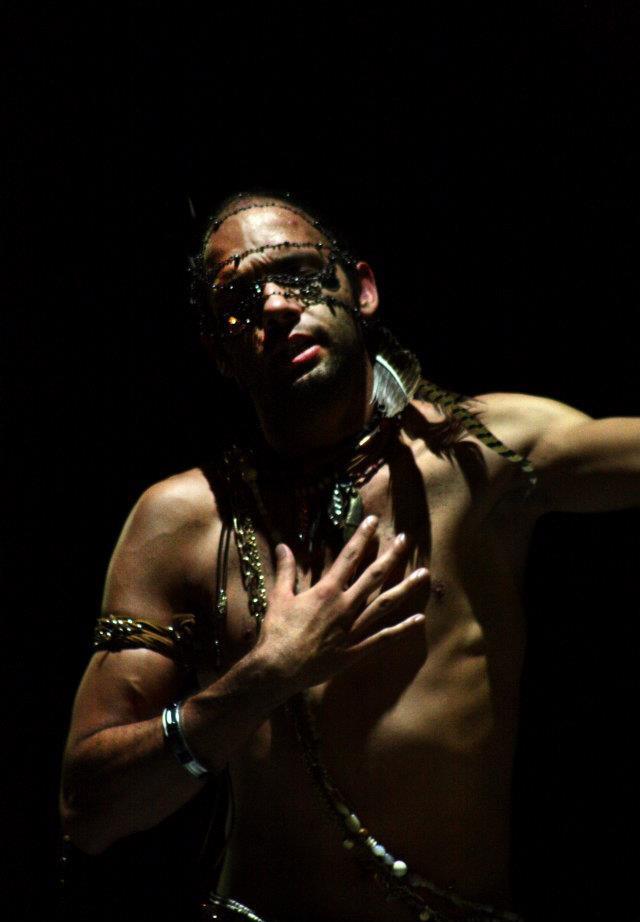
The Athletic Artistry of Frank Farinaro
by Brittany Capozzi
Jaylee and Heather Powers host tribal-fusion dancer Frank Farinaro (New Mexico) the weekend of Sept. 12 – 14 in Portland. Visit the event page to get more info and to sign up. Contributing writer Brittany Capozzi interviewed Mr. Farinaro about his background, his Hammerhead Sharqui technique, and the increased numbers of male dancers in tribal fusion.
 What does your artistic background/education consist of?
What does your artistic background/education consist of?
I would say that my artistic background and education is unconventionally broad. Ever since I was a child, I have loved art, science, history, fitness, and education. I apply elements to my craft that I have learned from elementary school, all the way up to what I learned in a rehearsal last week. The condensed description of my artistic background is a combination of focused classes, workshop intensives, academic research, real-life experiences, and experimentation.
In your Tribal Fest biography, you describe Hammerhead Sharqi as “athletic artistry” with “emotional expression”. It sounds like there are dualities to this dance- a hardness and softness -so how does one know if it is right for him/her? What is the choreography like?
“Athletic artistry” was actually a description of my dancing by Princess Farhana. The cornerstone of my Hammerhead Sharqi Technique is about finding balance. No matter what style of dance one does, it requires a balance of athletic training and emotional expression. My first male belly dance mentor, Elijah Sound, taught me that each person is a result of the masculine meeting the feminine. So if dance is a celebration of life, then we celebrate by embodying the masculine and feminine energies that created us. Like most dance curricula, mine is rooted in foundational dance technique and focuses on conditioning, practice, execution, performance, and instruction/mentorship. But unlike most regimented forms of dance, mine focuses on teaching the individual to dance to the best of their own abilities and find their own artistic voice. Finding one’s own artistic voice is a big draw of this dance form.
My goal is to help dancers dance for their unique body type and create their own experiences. It’s here that you learn what looks best for your body, how to dance in a troupe with different bodies, and performer/audience psychology. In choreography, I like to teach my students how to make commanding entrances and powerful exits. Everything that falls in between is the meat of the sandwich. That is where we focus on the communicative elements of performance art – to find our voice, effectively address an audience, and generate the reaction we want. It’s with this intrinsic exploration that we create more cohesive projections when we perform or teach.
Are meditative practices incorporated in Hammerhead Sharqi Dance? If so, how?
I take a very East-meets-West approach to my teaching and dancing. There are a lot of focused meditations in the form of mind-body communication for isolations and muscle memory, rhythmic trance for breath and musicality, emotional exploration for Method Acting, and visualization for production and performance.
As a performer of the Rakkas Festival, which features male tribal fusion belly dancers, do you see more men becoming involved in the craft, shifting the paradigm, as opposed to shying away from it? Is there more liberation with expression out there than there used to be, before Rakkas Festival was created?
The first Rakkas Festival that Mark and Matt Bissell produced in 2012 made very bold statements by having an all-male cast of belly dancers and an all-female drum ensemble. This year’s Rakkas followed a similar formula, but was a tribal-specific event. I think that that also spoke to the legitimacy of tribal being recognized today. When I first entered the bellydance scene in 2005, I noticed that there were quite a few male dancers, all over the world, who danced all styles fitting under the belly dance umbrella, who were working on ambitious projects. With us all being so scattered, it makes it difficult/impossible to work together. But our dedication to our craft, and our feelings of being minorities have bred a strong sense of comraderie. Some of us lovingly call it “The Brotherhood of the Sisterhood.”
The belly dance world is experiencing three major events: men being recognized for their dance achievements, Middle-Eastern dance/culture being recognized by the mainstream, and a generational-shift. I feel that this dance attracts people from all walks of life, but to see that there are a handful of men nearing the front of the pack in this female-dominated scene is very inspiring to other men who are intrigued to explore this art form. I think if I would have seen the scene now, back then, I would have started belly dancing a lot sooner. As more of us men have emerged, there has been a growing amount of talk (both joking and serious) that there is a competitiveness among us, but events like Rakkas really allow us to showcase and celebrate our brotherhood.
Your lecture “The Belly Street Journal” (a lecture on community ethics, politics, economics, and demographics in the Bellyverse) sounds fascinating. What do you think are some of the biggest challenges in the bellyverse today?
The Belly Street Journal might be a bit controversial, as we will be discussing some hot-button issues, as well as avoiding and dealing with drama. I listed a few things that are affecting the Bellyverse today, in the previous answer. Some of the other topics that will be discussed are market-saturation, a guide to Personal vs. Professional, getting out on the festival circuit on a budget, and focused networking.
- August 15, 2014
- 710
- Belly Dance
- Comments Off on The Athletic Artistry of Frank Farinaro

